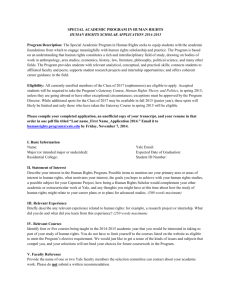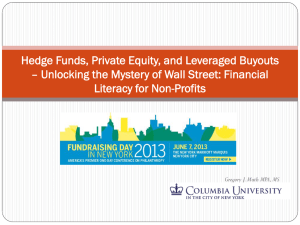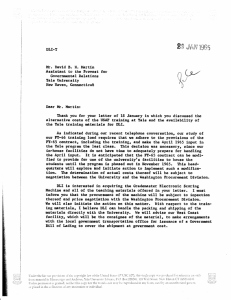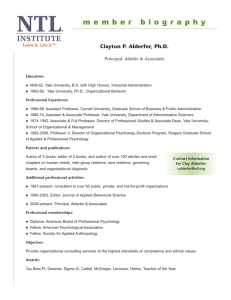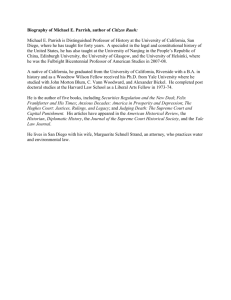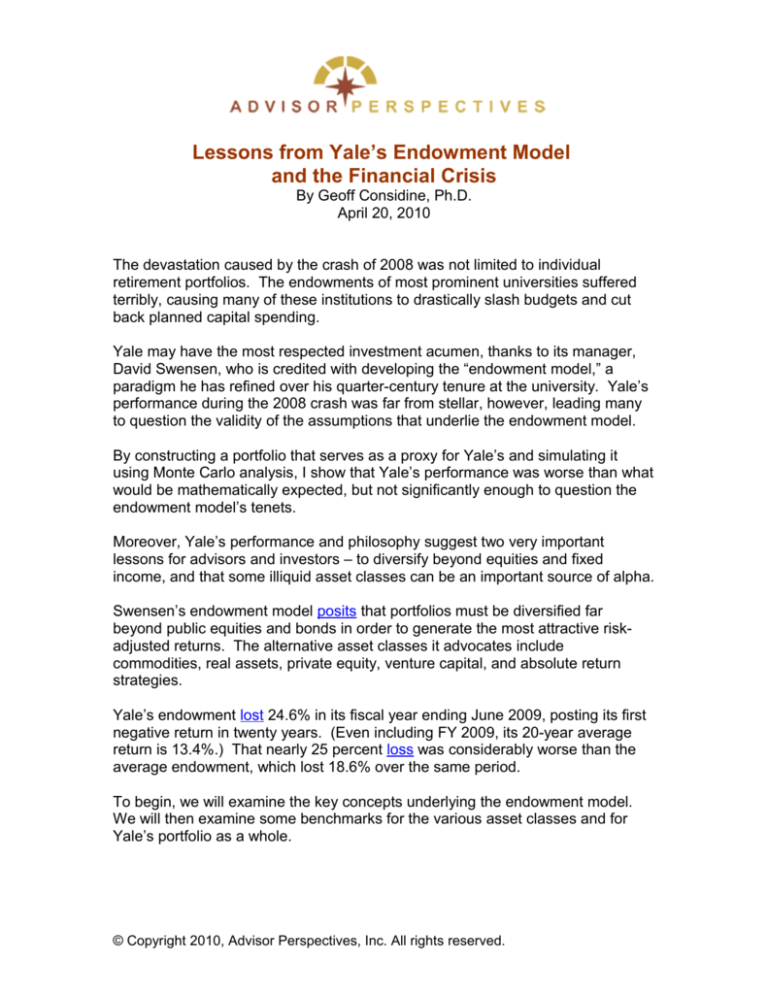
Lessons from Yale’s Endowment Model
and the Financial Crisis
By Geoff Considine, Ph.D.
April 20, 2010
The devastation caused by the crash of 2008 was not limited to individual
retirement portfolios. The endowments of most prominent universities suffered
terribly, causing many of these institutions to drastically slash budgets and cut
back planned capital spending.
Yale may have the most respected investment acumen, thanks to its manager,
David Swensen, who is credited with developing the “endowment model,” a
paradigm he has refined over his quarter-century tenure at the university. Yale’s
performance during the 2008 crash was far from stellar, however, leading many
to question the validity of the assumptions that underlie the endowment model.
By constructing a portfolio that serves as a proxy for Yale’s and simulating it
using Monte Carlo analysis, I show that Yale’s performance was worse than what
would be mathematically expected, but not significantly enough to question the
endowment model’s tenets.
Moreover, Yale’s performance and philosophy suggest two very important
lessons for advisors and investors – to diversify beyond equities and fixed
income, and that some illiquid asset classes can be an important source of alpha.
Swensen’s endowment model posits that portfolios must be diversified far
beyond public equities and bonds in order to generate the most attractive riskadjusted returns. The alternative asset classes it advocates include
commodities, real assets, private equity, venture capital, and absolute return
strategies.
Yale’s endowment lost 24.6% in its fiscal year ending June 2009, posting its first
negative return in twenty years. (Even including FY 2009, its 20-year average
return is 13.4%.) That nearly 25 percent loss was considerably worse than the
average endowment, which lost 18.6% over the same period.
To begin, we will examine the key concepts underlying the endowment model.
We will then examine some benchmarks for the various asset classes and for
Yale’s portfolio as a whole.
© Copyright 2010, Advisor Perspectives, Inc. All rights reserved.
An overview of the Endowment Model
The annual reports issued by Yale’s endowment provide an overview of the
philosophy that drives the endowment model. We will examine a number of the
key principles.
Increased diversification
If diversification fails to protect a portfolio in the face of a financial panic, why
bother to diversify? The answer lies in the diversified portfolio’s lower risks and
higher returns.
(p. 3)
Diversification is a core tenet of the endowment model, even though diversifying
may not provide much protection from a financial crisis. Many investors
mistakenly believe that diversification is a key risk management tool, and the
quote above notes that the truth is more nuanced. The idea that a welldiversified portfolio is a low-risk portfolio is common, but portfolio theory certainly
doesn’t suggest that this is the case. A diversified portfolio has higher average
expected return for a lower average risk level, but that is a far cry from the idea
that a diversified portfolio is somehow sheltered from the effects of a market
collapse.
Higher equity allocations
As to equity orientation, history teaches us that over reasonably long holding
periods, higher-risk equities outperform lower-risk bonds. In fact, for the capitalist
system to function properly, expected returns for equities must exceed expected
returns for bonds. Both practice and theory point long-term investors toward
portfolios with significant holdings of equity positions. (p. 3)
Another key theme of the endowment model is that long-term investors will be
well served by substantial exposure to equities and to asset classes with equitylike risk. This quote does not pertain only to publicly listed firms, however, and
Yale maintains a substantial allocation to private equity. Essentially, Yale
believes in the equity risk premium and, since its time horizon is substantially
longer than that of individual investors, it can tolerate volatility over the short term
for the sake of achieving higher long-term returns.
Embrace active management
Despite recognizing that the U.S. equity market is highly efficient, Yale elects to
pursue active management strategies, aspiring to outperform the market index
by a few percentage points annually. Because superior stock selection provides
© Copyright 2010, Advisor Perspectives, Inc. All rights reserved.
the most consistent and reliable opportunity for generating excess returns, the
University favors managers with exceptional bottom-up fundamental research
capabilities. Managers searching for out-of-favor securities often find stocks that
are cheap in relation to current fundamental measures such as book value,
earnings, or cash flow.(p.12)
Yale employs active management as a key component across the asset classes
in which it invests. Active management in the portfolio emphasizes stock picking
and fundamental strategies that look for under-valued assets.
Note, however, that Yale specifically structures its relationships with active
managers to avoid the perverse incentives that are often inherent in the structure
of active management (e.g., asset-based fees for public mutual funds which
reward managers irrespective of their performance), as this quote illustrates:
An important attribute of Yale’s investment strategy concerns the alignment of
interests between investors and investment managers. To that end, absolute
return accounts are structured with performance related incentive fees, hurdle
rates, and clawback provisions. In addition, managers invest significant sums
alongside Yale, enabling the University to avoid many of the pitfalls of the
principal-agent relationship. (p.11)
Yale has this crucial ability with regard to selecting active managers that
individuals do not.
Exploit liquidity risk
Investors frequently encounter opportunities to generate excess returns from
accepting illiquidity. Of course, the correct conclusion is not to pursue every
premium return associated with illiquid assets and the thereby create a
completely illiquid portfolio.(p. 3)
The endowment model has notably altered the investing paradigm in the area of
target portfolio liquidity. Illiquid assets are those which may not necessarily be
purchased or sold for a ‘fair’ price at any given time. Particularly in times of
market stress, certain assets may become unpopular and the available prices at
which they can be sold may be far below fair value. Those who are forced to sell
at these times are paying the price for taking on illiquid assets. There is a
growing body of research that supports the notion that illiquid assets often
provide the potential for high returns, however, and Yale’s model exploits those
opportunities.
© Copyright 2010, Advisor Perspectives, Inc. All rights reserved.
Rely on traditional portfolio theory
Yale’s portfolio is structured using a combination of academic theories and
informed market judgment. The theoretical framework relies on mean variance
analysis, an approach developed by Nobel Laureates James Tobin and Harry
Markowitz, both of whom conducted work on this important portfolio
management tool at Yale’s Cowles Foundation. Using statistical techniques to
combine expected returns, variances, and covariances of investment assets,
Yale employs mean-variance analysis to estimate expected risk and return
profiles of various asset allocation alternatives and to test sensitivity of results to
changes in input assumptions. (p.5)
This paragraph reads like a textbook definition of portfolio theory. My work has
shown the consistency in risk-adjusted performance between the endowment
model and portfolios that are designed based on portfolio theory. My Monte Carlo
analysis uses rational forward-looking estimates of risk and return for the range
of possible asset classes (see here and here).
Increase allocations to alternative asset classes
The heavy allocation to nontraditional asset classes stems from their return
potential and diversifying power. (p. 7)
Real estate, oil and gas, and timberland share common characteristics:
sensitivity to inflationary forces, high and visible current cash flow, and
opportunity to exploit inefficiencies. Real asset investments provide attractive
return prospects, excellent portfolio diversification, and a hedge against
unanticipated inflation.(p.15)
From the perspective of portfolio theory, non-traditional asset classes such as
commodities provide value largely because they have low correlation to the
movements of the broader market, which means that combining these assets
with stocks and bonds allows a portfolio to generate higher risk-adjusted returns
than would otherwise be possible. An additional justification for alternative asset
classes is that they are less liquid, so it is more likely that the assets are not
properly priced. There is a growing literature on the excess return that
investment in illiquid assets can yield. Yale’s approach to alternative assets is
based on both of these effects.
Asset class risk and return
Yale identifies six major asset classes and provides expected rates of return and
risk estimates for each. These values, along with the target allocation to each in
Yale’s portfolio are shown below:
© Copyright 2010, Advisor Perspectives, Inc. All rights reserved.
Asset Class
Absolute Return
Domestic Equity
Fixed Income
Foreign Equity
Private Equity
Real Assets
Cash
Portfolio
Expected Real Return
6%
6%
2%
6%
11%
6%
Annualized Volatility
10.0%
20.0%
10.0%
20.0%
27.7%
13.6%
6.40%
13.20%
Target Allocation
15.0%
7.5%
4.0%
10.0%
26.0%
37.0%
0.5%
Yale’s Target Allocations and Expected Return and Risk
Yale states that it uses a rate of inflation that is 1% per year greater than the CPI
to reflect the higher rate of inflation in higher education, so we can then estimate
the expected total return from these asset classes if we assume a 4% base
inflation rate (3% for CPI + 1% additional).
Asset Class
Absolute Return
Domestic Equity
Fixed Income
Foreign Equity
Private Equity
Real Assets
Cash
Portfolio
Expected Return
10.0%
10.0%
6.0%
10.0%
15.0%
10.0%
Annualized Volatility
10.0%
20.0%
10.0%
20.0%
27.7%
13.6%
10.4%
13.20%
Target Allocation
15.0%
7.5%
4.0%
10.0%
26.0%
37.0%
0.5%
Yale’s Target Allocations and Nominal Return and Risk
To assess the reasonableness of the projected risks and returns for the various
asset classes, I created a series of proxies using ETFs. I then ran these proxies
through my Monte Carlo simulation to generate estimates for the risks and
returns for the various asset classes (see table below).
© Copyright 2010, Advisor Perspectives, Inc. All rights reserved.
Large Cap
Small Cap
Investment Grade
Intermediate Gov't
Long Gov't
High Yield
Developed Int'l
Emerging Markets
IVV
IWM
LQD
IEF
TLT
COY
EFA
EEM
Allocation in
Asset Class
50%
50%
30%
30%
30%
10%
70%
30%
Private Equity
Private Equity
PSP
100%
15.6%
30.2%
Real Assets
Utilities
Transport
Real Estate
Commodities
Gold
XLU
IYT
RWR
DJP
GLD
30%
15%
15%
25%
15%
9.8%
15.1%
Asset Class
Domestic Equity
Fixed Income
Foreign Equity
Fund
Ticker
Projected Average
Annual Return
Projected Volatility
9.2%
17.0%
6.0%
7.1%
11.0%
20.5%
Monte Carlo Projections for Yale’s Asset Classes
Overall, the projected risks and returns for the various asset classes from my
Monte Carlo simulation agree closely with Yale’s projections.
In the case of private equity, I used PSP, a fund designed to track an index of
public private equity firms. The real asset component of the portfolio is
somewhat harder to approximate. I have created the real asset sub-portfolio by
combining utilities, transport stocks, REIT’s, commodities, and physical gold.
The hardest component of Yale’s projections to reasonably approximate is the
Absolute Return (AR) component. While there are funds with this designation,
the performance of this ‘asset class’ is so dependent on manager skill that it is
inappropriate to rely on them as a proxy for AR performance. AR strategies are
supposed to be market-neutral, with near-zero beta. By allocating the 15% that
is supposed to go to AR to a short-term bond fund as a conservative proxy, my
Monte Carlo projections give this portfolio a projected return of 10% with a
volatility of 16.2% (using data through March 2010). If I allocate the 15%
targeted to AR to investment-grade corporate bonds (using the LQD ETF), the
projected return is 10.5% with volatility of 17%. This seems like a better fit for
AR, at least in terms of risk level and impact on the portfolio, because LQD has
projected volatility of 9.1% – quite close to the 10% projected by Yale for AR.
Overall, the projected return and risk for our representative portfolio – 10.5% and
17%. respectively – are quite similar to the Yale’s projected return and risk of
10.4% and 13.2%, especially given the challenges in creating a reasonable
proxy. A more critical selection of individual investments can certainly add return
relative to the market-cap weighted indexes that we have assumed. Further, we
have ignored the potential value that active management could add. My own
research suggests that it is plausible that an absolute return strategy could
© Copyright 2010, Advisor Perspectives, Inc. All rights reserved.
generate 10% in return with 10% in annualized volatility (as Yale projects for the
AR component of the portfolio). In fact, I have found that this appears to be a fair
estimate of what is possible.
Overall, then, our Monte Carlo simulations are broadly in agreement with Yale’s
projections, justifying Yale’s estimates of various asset class returns. Our
estimates of the portfolio risk and return using index-based asset classes result
in a similar projected return, albeit with higher risk than Yale’s estimates. Yale
uses derivative instruments to manage risk, and some of the additional return
that they expect to receive from their AR strategies could fund the purchase of
risk-reducing options and swaps in their portfolio, bringing the risk levels of Yale’s
and our Monte Carlo simulations closer into alignment.
Could the magnitude of potential loss in 2008-9 have been anticipated?
One of the largest questions on peoples’ minds with regard to the endowment
model is whether the substantial losses in FY 2009 indicate flaws in the
underlying model. The almost 25% loss in Yale’s endowment was a shock.
Yale’s 2008 report states that the expected real return of the portfolio is 6.4%,
which translates to 10.4% in nominal return. The projected risk level was 12.7%
in annualized volatility. If we run our Monte Carlo simulation using data through
June of 2008 for the proxy portfolio that we created for Yale, we get an expected
return of 9.3% with annualized volatility of 11.7%. Note that this is still assuming
that Absolute Return is approximated by investment-grade bonds. Based on
these estimates, what is the worst than can happen?
The S&P500 lost approximately 26% for the year ending June 2009, so the
losses in Yale’s endowment were on track with the market. The risk level that
Yale projected for their overall portfolio was 12.7%, however, which is far less
volatile than the 20% risk level that they estimated for domestic equities. The
losses in FY 2009 to Yale’s portfolio were much more severe relative to their
expected risk level than were the losses from domestic equities.
The answer to the question posed at the start of this section, then, is somewhat
nuanced. The level of loss suffered by Yale’s portfolio was within the estimated
realm of possibility, although it was somewhat higher than was predicted by
Yale’s estimate of risk for its portfolio. This situation contrasts starkly, for
example, with the events that famously destroyed Long Term Capital
Management, which had been estimated as absolutely impossible over the
multiple lifetimes of the universe.
© Copyright 2010, Advisor Perspectives, Inc. All rights reserved.
What can we conclude?
While FY 2009 was a painful one for Yale, its 20-year annualized return of 13.4%
is remarkable. One bad year is insufficient evidence to discount the conceptual
framework developed by Swensen and his team. The Yale model combines
portfolio theory with a focus on selecting active managers who will add value.
While I cannot judge the active component of Yale’s strategy, I can offer some
broad observations.
First and foremost, Yale has consistently stated that the vast majority of its
assets are invested in asset classes with risk and return properties consistent
with equities, resulting in an overall allocation that is not low-volatility. With only
4% of the target asset allocation in bonds, it cannot be surprising that this
portfolio lost almost as much as the S&P500 in FY 2009.
For individual investors and advisors, one take-away is that diversification works
to increase risk-adjusted returns over long periods, but it does not provide much
protection during severe market dislocations. This conclusion applies to all
portfolios, not just Yale’s.
My analysis of the risk exposure in Yale’s portfolio suggests that its true risk is
higher than Yale’s estimates, but I do not have the details of the Yale holdings.
The risk in my synthetic portfolio could be reduced by carefully selecting lowcorrelation components and hedging with derivatives, bringing its risk closer to
that of Yale’s.
In my analysis, I have not explicitly accounted for the relative impact of illiquidity
on portfolio performance. With an additional source of alpha (via adding illiquid
assets), we could easily end up with the same expected returns, but lower total
portfolio risk, and we could match Yale’s projections even more closely.
Research by Roger Ibbotson suggests that an investment strategy that targets
illiquid public securities has historically generated a high level of alpha (greater
than 5% per year). Investors and advisors who wish to follow Yale’s approach of
trying to increase portfolio returns by taking on liquidity risk may do so using
relatively illiquid (but public) securities. Illiquid public securities also tend to have
high levels of non-market (i.e., non-systematic) risk. In fact, this research
suggests that non-systematic risk is the key driver of surplus return and that the
illiquidity is secondary. To build a sub-portfolio with elevated levels of nonsystematic risk, one could combine low-beta, low-R-squared stocks. These
stocks naturally tend to have higher proportions of non-systematic risk, lower
liquidity, and have historically reaped premium returns. We will explore model
portfolios that exploit these effects in a future article.
© Copyright 2010, Advisor Perspectives, Inc. All rights reserved.
Implications for advisors and investors
The endowment model (as practiced by Yale) makes sense when viewed
through the lens of our Monte Carlo simulations. Its FY 2009 returns were within
reasonable estimates of probability. The emphasis on alternative asset classes
in Yale’s portfolio means that even comparing the returns from the S&P500 to the
endowment portfolio is somewhat suspect. Perhaps Yale placed too much faith
in the lack of correlation between its portfolio and the movements of the broader
capital markets, but the overall logic behind Yale’s model is perfectly sound, even
in light of FY 2009.
Swensen remains a staunch advocate of the principles of portfolio management
that we have laid out in this discussion. The long-term record of Yale’s
endowment, combined with the approach’s consistency with financial theory,
validates his position.
The lessons for advisors and individual investors who wish to gain some of the
advantages of the endowment model are:
1)
2)
3)
4)
Bet on the equity risk premium
Diversify far beyond stock and bond indexes
Exploit low-liquidity asset classes where appropriate
Neither (2) nor (3) will necessarily provide protection in a market crisis
These conclusions do not mean that one should invest in private equity, venture
capital or hedge funds, however. Swensen makes it clear that Yale’s advantages
in these areas stem largely from the ability to uniquely align incentives with
managers, a capability that individuals do not have, as well as his expertise and
the extensive resources available to him to select and monitor Yale’s managers.
Fortunately, there are other ways for us to exploit the benefits available from real
assets and from relatively illiquid investments.
Quantext Portfolio Planner is a portfolio management tool. Extensive case studies, as well as
access to a free extended trial, are available at http://www.quantext.com
Quantext is a strategic adviser to FOLIOfn,Inc. (www.foliofn.com), an innovative
brokerage firm specializing in offering and trading portfolios for advisors and individual investors.
www.advisorperspectives.com
For a free subscription to the Advisor Perspectives newsletter, visit:
http://www.advisorperspectives.com/subscribers/subscribe.php
© Copyright 2010, Advisor Perspectives, Inc. All rights reserved.

